Mark Sisson's Blog, page 286
September 22, 2014
Dear Mark: High Uric Acid and Gout; From Vegetarian to Primal Without a Gallbladder
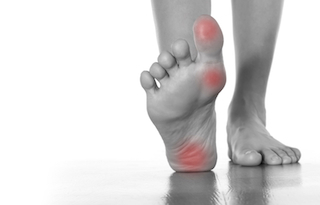 For today’s edition of Dear Mark, I’m covering two questions. First, what’s the deal with really, really high uric acid levels? Assuming a person is fit with good body composition, feels good, and has no complaints, are they still worrisome? Can they still lead to gout? Maybe. Read on. And then I cover a question on the best way to transition from vegetarian to Primal. If that seems fairly standard, there’s a little wrinkle: the potential convert has no gallbladder.
For today’s edition of Dear Mark, I’m covering two questions. First, what’s the deal with really, really high uric acid levels? Assuming a person is fit with good body composition, feels good, and has no complaints, are they still worrisome? Can they still lead to gout? Maybe. Read on. And then I cover a question on the best way to transition from vegetarian to Primal. If that seems fairly standard, there’s a little wrinkle: the potential convert has no gallbladder.
Let’s go:
Just read your article on 12 reasons to consume more protein. My uric acid levels are pretty high at 40 on the scale… Doctor says i’ts on the verge of becoming an issue and can develop into gout. I don’t have any gout problems now, but I also don’t want them. I have been eating a Primal Blueprint diet for the last 21 months, and have dropped 27 lbs and 6 inches off my waist. I am 47 years old, 6′ 1″ tall and weigh 187 lbs now! I look lean and fit with good muscle mass and feel good. Any advice on the protein and uric acids?
Thanks,
Chris
Given that vegans have higher uric acid levels than meat eaters, fish eaters, and vegetarians, the standard recommendation to reduce meat intake in the face of high uric acid doesn’t really apply to most Primal eaters. In fact, protein intake usually increases uric acid excretion and lowers uric acid levels. But 40 (mg/dL, I assume) is astoundingly high. The upper end of the reference range for males is 7.2 mg/dL, with anything above that qualifying a person for hyperuricemia. Severe hyperuricemia, or anything over 10 mg/dL for males, is very strongly associated with gout. If that’s a correct reading, something is impairing clearance and it very well could lead to gout if it’s a chronic, rather than transient, issue. Until you get it figured out, I would reduce foods high in purines (which break down to uric acid). That means red meat, shellfish, and organ meats.
But let’s explore some possibilities:
If you’re in the early stages of a ketogenic diet, your uric acid levels will spike because the kidney disposes of excess ketones and uric acid through the same pathway. People new to ketosis are hit with elevated levels of ketones and an inability to utilize them all; as time goes on and you become keto-adapted (with tissues prepared to utilize ketones), serum ketones won’t be high enough to interfere with uric acid disposal and serum levels should normalize. That’s one option. If you’re not transitioning to ketosis (either because you’re not eating a ketogenic diet or you’re already keto-adapted), that’s not it.
Intermittent fasting can impair uric acid clearance (PDF). In that study, however, long term fasting only got uric acid levels up to 22.5 mg/dL per 100 cc of blood. You’re at almost twice that, so I doubt that fasting is the only cause here. It could make the issue worse, of course.
You might be really dehydrated. Severe dehydration concentrates the serum and throws the uric acid measurement way off. In fact, the only reference I was able to find for uric acid levels approaching 40 mg/dL were in patients with “volume depletion.” These guys had no kidney issues; they were just really, really dehydrated. A few days of IV hydration normalized the uric acid levels.
Intense aerobic exercise spikes uric acid levels for several days. The more fast twitch muscles you utilize, the higher it spikes and the longer the spike lasts. Heavy squats and explosive power training also cause a “remarkable increase” in uric acid levels of trained weightlifters. Since both high-intensity metabolic conditioning (sprints, HIIT, etc) and strength training are healthy endeavors, any related elevations in uric acid are unlikely to be pathological. You’re a muscular guy, presumably exercising on a regular basis, right?
Insulin resistance and metabolic syndrome are strongly correlated with hyperuricemia. It doesn’t sound like you have either of those, though.
It’d also be worth trying out some dietary modifications that have been shown to reduce uric acid levels. Cherries (especially tart cherries), vitamin C, and mineral water with good sodium bicarbonate content can all lower serum uric acid.
And watch out for your alcohol and fructose intake, as both increase serum uric acid.
I wish I could tell you to ignore the numbers since you’re fit, strong, and feeling good – but I can’t do that. It could be a perfect storm of acute but otherwise benign serum uric acid modifiers. I hope it is, because acute, transient elevations in uric acid are actually protective against oxidative stress (uric acid is an antioxidant in the right doses, after all). But 40 mg/dL is high. You should follow up with your doctor, get re-tested, and see if it was just a temporary, transient fluctuation before brushing it off. Make sure you’re hydrated, don’t fast, and skip your intense workouts in the days leading up to a re-test.
Good luck, Chris, and keep me posted!
My husband & I switched to a Paleo lifestyle this past mid May. He has lost 23 lbs and I have lost 12 lbs with just changing what we eat. We love how we feel, plus the fact that we don’t get hungry between mealtimes.
Our son, who needs to lose around 100 lbs, has been watching and is showing interest in going Paleo. The short version of his health history is he has a blood disorder (spherocytocis) that caused him to have his spleen and gall bladder removed at the age of 8. After that he steadily gained weight over the years. He is 17 years old now and has been a vegetarian since last fall. My question is this: IF he chooses to go Paleo should he switch cold turkey or transition gradually? The reason he went vegetarian was IBS issues. Without his gallbladder he has a difficult time processing and digesting fat.
Thanks,
Shannon
That’s a big change – going from vegetarian to paleo/Primal without a gallbladder – and he’ll have to make it carefully.
When you’re a vegetarian, your body reduces its production of specific animal protein-digesting enzymes. You don’t need them, so why make them? Just a month or so is enough to downregulate enzyme production. So he’ll need a few days or even a week to begin producing enough elastase (which breaks down connective tissue in animal foods – cartilage, tendon, fascia, the delicious gristly bits) and chymotrypsin (which breaks down protein in general) to handle regular amounts of meat. As long as he doesn’t start out with two pounds of lamb shanks for his first meal back, he’ll be fine.
He’s only been a vegetarian for less than a year, though. I don’t envision a huge transition. I’ve had longtime (10+ years) former vegan friends who throw up the first time they have steak. Totally normal for them. Also, the fact that he doesn’t seem to have an ideological or ethical issue with animal consumption should help smooth the transition. That’s often the biggest hurdle to overcome; the sensation that you’re a moral failure by ripping into a rare steak and relishing the juices running down your chin can be debilitating.
The good news for your son is that going Primal can be extremely protective against IBS. You know, I had IBS for years back when I was a grain-eating endurance athlete, and it was probably the first thing that cleared up once I gave up grains and started eating more fat and protein. Wheat famously (and infamously) exacerbates and even causes IBS in some patients; removing it (going Primal) makes for an effective, simple dietary treatment. The large amounts of insoluble fiber found in grains don’t seem to help IBS patients, either. Soluble fiber found in the roots, fruits, and vegetables your newly Primal son will eat does help, however.
He should be careful with FODMAPs, too, AKA fermentable, oligosaccharides, disaccharides, monosaccharides, and polyols. They’re a common trigger for people with IBS, and they appear in a lot of otherwise totally innocuous and downright beneficial foods (dairy, certain fruits and vegetables). Have him check out the post I did on FODMAPs. He might see some familiar faces from his vegetarian days. Luckily, even if FODMAPs are a problem for him, he can slowly reintroduce them and gradually increase the amount he eats, given sufficient time and gut health rehabilitation.
How about the gallbladder issue?
Since the gallbladder stores, concentrates, and releases bile to help break down dietary fat, his particular mode of Primal eating may have to be lower in fat than most. That’s okay; it’s not the deal breaker some would have you believe. While I find the higher-fat approach to Primal eating to be optimal for me and most people, it’s not necessary. Just stick to the basics – animals, plants, good fats – and avoid grains, refined sugar, and processed seed oils, and he’ll do great. The absolute ratios don’t matter as much as the quality of food you eat and don’t eat. Besides, as he loses weight he’ll be consuming his own body fat (a process which does not require a gallbladder). Once he’s lost the weight and is a bit more insulin sensitive, extra carbs shouldn’t pose any problems.
He’ll still be able to eat fat, of course, and his bathroom visits will tell him if he’s eating too much because undigested fat will show up in his stool. It’s more messy and annoying than dangerous. Coconut oil, MCT oil, and pastured dairy fat contain medium chain triglycerides that require less gallbladder input. These will be easier to digest and should be favored.
Ox bile supplements can help him break down fat. If you have access to an ox and its bile, that would probably be even better (if a bit more disgusting), but supplements can help the gallbladder-less digest fats.
Good luck to your son!
That’s it for today, everyone. Be sure to chime in with your experiences, insights, and comments!
Further Your Knowledge. Deepen Your Impact. Become an Expert! Learn More About the Primal Blueprint Expert Certification




September 21, 2014
Weekend Link Love – Edition 314
 For everyone that’s been inquiring, this year’s annual 21-Day Challenge is postponed to January 1. Check back in 2015 to take part in the next challenge. I’ve got some fun stuff planned.
For everyone that’s been inquiring, this year’s annual 21-Day Challenge is postponed to January 1. Check back in 2015 to take part in the next challenge. I’ve got some fun stuff planned.
Check out the trailer for a great new movie – Carb-Loaded: A Culture Dying to Eat. It comes out October 1 and features a who’s who of obesity and nutrition experts.
Pure Food. Pure Training. is a colorful interactive iBook with delicious recipes, videos, functional fitness workouts and tips on how to integrate a Primal lifestyle into your daily life. The author, Romy Dollé, joined us at PrimalCon Tulum and lives with her family in Zurich, Switzerland. I highly recommend checking it out.
Research of the Week
Human facial diversity evolved to make it easier for us to recognize each other.
Why isn’t evolutionary psychology more widely accepted in the scientific community?
Dawn simulation (light exposure during last 30 minutes of habitual sleep) improves alertness and cognitive and physical performance.
Cycling or walking to work – also known as active commuting – improves psychological health.
Obese people who experience rapid, early weight loss are the most likely to stick with a diet and achieve success. Hmm, I wonder which sort of diet produces the rapidest, earliest weight loss.
New Primal Blueprint Podcasts
Each week, select Mark’s Daily Apple blog posts are prepared as Primal Blueprint Podcasts. Need to catch up on reading, but don’t have the time? Prefer to listen to articles while on the go? Check out the new blog post podcasts below, and subscribe to the Primal Blueprint Podcast here so you never miss an episode.
Walking: The Human Condition
A Brief History of the Primal Movement
Mark’s Daily Apple Best of 2014, Vol. 2: Exercise and Performance
The Definitive Guide to the Primal Blueprint
Interesting Blog Posts
Dr. Ron Sinha tackles the sordid story of illicit carb trafficking.
According to data that’s mysteriously vanished from the latest version of the European Heart Survey data sets, there is no relationship between saturated fat intake and cardiovascular disease deaths in any European country (there might even be an inverse relationship, if anything).
How Russia’s background as a seed oil producer (dating back to the 1700s) might partially explain the elevated heart disease death rates in former Soviet Union countries.
Media, Schmedia
Which would you choose – CrossFit or yoga?
One guy’s (poorly thought out) issues with the paleo diet.
Everything Else
“Sugarcane has caused greater loss of biodiversity on the planet than any other single crop…”
I know where I’m eating for the next seven weeks!
America’s biggest problem is a lack of sleep – and an inability to recognize that it’s actually a problem for us.
A Danish town is experiencing a massive invasion by large, delicious immigrants.
Ancient Egyptians’ got their hair did.
Former vegan Angelina Jolie’s beauty secret? Steak.
Steve Jobs didn’t let his kids use iPhones or iPads.
Recipe Corner
Anthocyanins and astaxanthin come together when you make blueberry glazed salmon.
Stuffing food into food is great: stuffed squash.
Time Capsule
One year ago (Sept 21 – Sept 27)
The 10 Habits of Highly Successful Hunter-Gatherers – They did a lot more than just eat and exercise right.
Cavemen Ate $12 Burgers: A Historical Perspective on Food Prices – Cheap food is a historical aberration.
Comment of the Week
Women who carry a little extra weight live longer than the men who mention it.
– Well done.





September 20, 2014
Primal Celery Root Lasagna
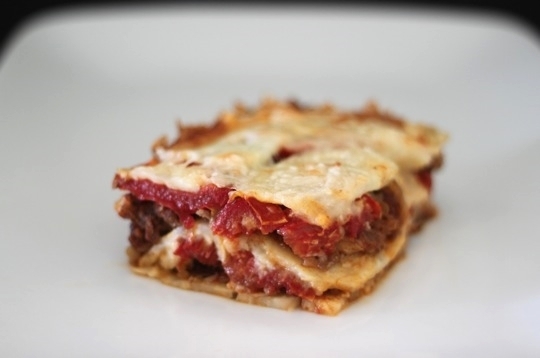 If lasagna is comfort food that you just can’t quit thinking about, then pull out that lasagna pan because this recipe is going to make you really happy. Even the most carb-addicted, pasta-loving person you know will be hard pressed to admit that this Primal lasagna isn’t delicious. This lasagna is the real deal – minus the noodles, of course.
If lasagna is comfort food that you just can’t quit thinking about, then pull out that lasagna pan because this recipe is going to make you really happy. Even the most carb-addicted, pasta-loving person you know will be hard pressed to admit that this Primal lasagna isn’t delicious. This lasagna is the real deal – minus the noodles, of course.
In place of noodles are thin sheets of celery root, a vegetable with a mild flavor and tender texture that does a fine job of impersonating a lasagna noodle. Extra scraps of celery root are pureed with butter to give the lasagna a creamy middle, no ricotta or béchamel sauce needed. This recipe isn’t completely dairy-free though, because if you’ve been really craving lasagna, then a cheese-free version just isn’t going to cut it. However, if you don’t do dairy no matter what, then you can use this recipe as inspiration to make a cheese-free casserole of meat and veggies layered with celery root (and let us know how it turns out).
But if it’s lasagna you want, then you’ll love these ultra-satisfying layers of roasted tomatoes, ground beef, and mozzarella and Parmigiano-Reggiano cheese. Comfort food has never tasted so good.
Servings: 4 to 6
Time in the Kitchen: 1 hour 15 minutes, plus 30 minutes to bake lasagna
Ingredients:
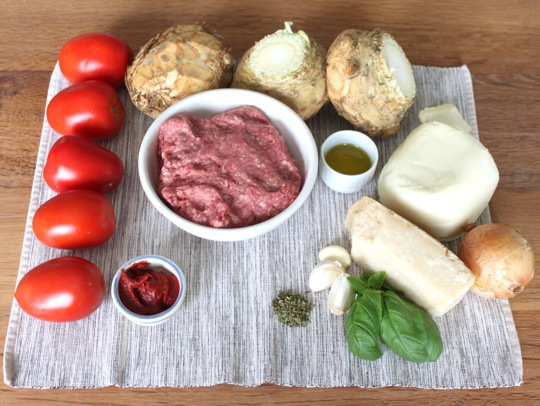
6 Roma tomatoes, cut into fourths lengthwise
5 tablespoons extra virgin olive oil, divided (75 ml)
3 large celery root
3 tablespoons butter (45 g)
1 small onion, finely chopped
3 garlic cloves, finely chopped
1 pound ground beef (450 g)
1 teaspoon dried oregano (5 ml)
2 tablespoons tomato paste (30 ml)
2 tablespoons chopped fresh basil (30 ml)
1 cup grated mozzarella cheese (approximately 90 g)
1/4 cup grated Parmigiano-Reggiano cheese (22 g)
Instructions:
Preheat the oven to 325 ºF/163 °C.
Toss the cut tomatoes with 3 tablespoons (45 ml) olive oil. Line a rimmed baking sheet with parchment paper (to prevent sticking) and lay the tomatoes on the baking sheet, evenly spaced. Lightly salt and pepper. Bake for 1 hour and 15 minutes, until the tomatoes are very soft and wrinkled.
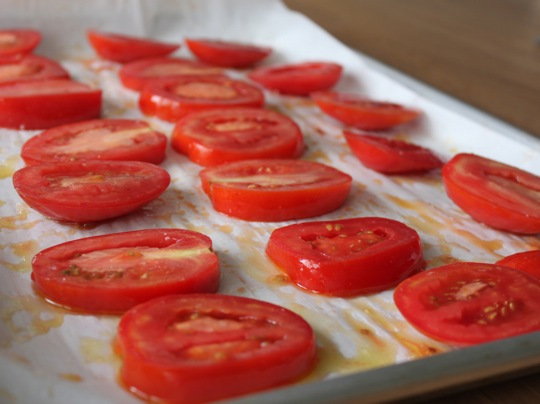
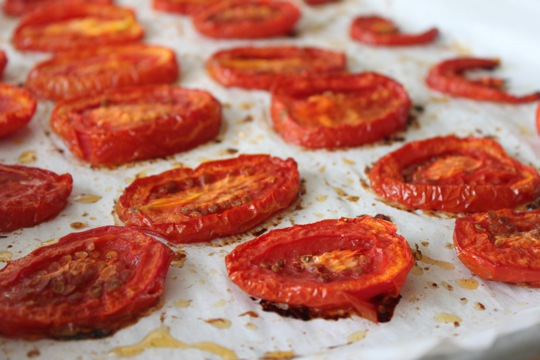
Use a paring knife to trim the skin off the celeriac root. Use a larger knife to cut each root into a square shape. Save the scraps that are trimmed off and set aside.
Cut each square celery root into very thin square/rectangular sheets, 1/8 to 1/4 inch thick. (3 mm to 6 mm)
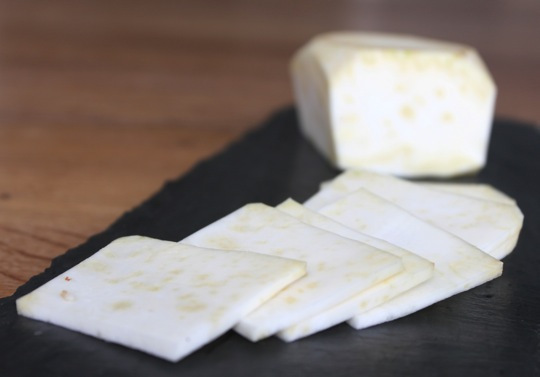
Bring a pot of water to a gentle boil. Add the sheets of celery and boil for 3 to 5 minutes until tender and easily pierced with a fork. Use tongs or a slotted spoon to lift the sheets out of the water. Set on a towel to cool.
Cut the celery root scraps that were set aside into pieces that are about the same size. Drop the pieces into the boiling water, cooking until tender. Drain. While still warm, puree in a food processor with the butter until very smooth. Add salt to taste. Hopefully, you have about 1 cup of puree.
In a sauté pan over medium-high heat, warm the remaining 2 tablespoons (30 ml) of olive oil. Add the onion and garlic and cook for 3 minutes then add the ground beef. Season with salt and pepper.
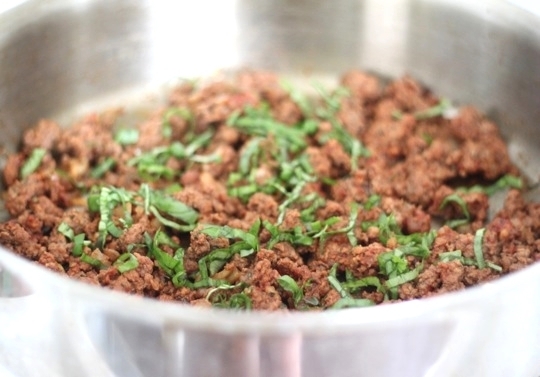
As soon as the meat is no longer pink, stir in the oregano and tomato paste. Continue to cook until the meat is browned. Turn off the heat and stir in the basil. Add more salt to taste if needed.
Preheat the oven to 375 °F/190 °C
Divide up the ingredients so you have enough for each layer, and in an 8×8 (20cm x 20cm) baking dish layer the ingredients in this order:
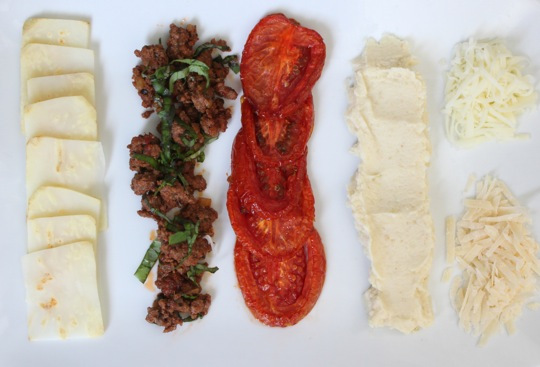
Celery root sheets
Meat
Tomatoes
Celeriac puree (use all of it)
Mozzarella
Celery root sheets
Meat
Tomatoes
Celery root sheets
Mozzarella
Parmigiano-Reggiano
Bake, uncovered, for 25 to 35 minutes until the cheese on top is nicely browned and bubbling. Let the lasagna sit at least 10 minutes before cutting into it.
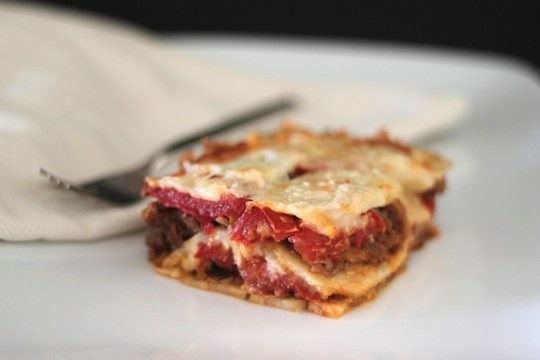
Not Sure What to Eat? Get the Primal Blueprint Meal Plan for Shopping Lists and Recipes Delivered Directly to Your Inbox Each Week




September 19, 2014
Overcoming Anxiety: I Finally Feel Comfortable in My Own Skin
It’s Friday, everyone! And that means another Primal Blueprint Real Life Story from a Mark’s Daily Apple reader. If you have your own success story and would like to share it with me and the Mark’s Daily Apple community please contact me here. I’ll continue to publish these each Friday as long as they keep coming in. Thank you for reading!
 I have always been a fit person. In my teens and early twenties I spent countless hours both weight lifting and performing extensive cardio routines in the gym. I worked hard in all areas of my life— juggling school, work, and an excessive fitness routine. I was young and insecure and put in two (or more) workouts per day to attain an ideal figure. I was in great shape, but over-stressed and exhausted from over-training. I had issues with reoccurring anxiety attacks as well as hypoglycemia. I was a solid 120 with great muscle definition and a low body fat percentage, but I didn’t feel healthy. I often felt weak and fatigued. By the age of 22, the pressure of work-life balance was causing issues in all aspects of my life. After visiting a physician, it was determined I should be administered anxiety medication to help my stress levels. Like most medications, selective serotonin re-uptake inhibitors (SSRI’s) are known to cause major side effect—one of the most common being weight gain. The medication, along with my heavy carbohydrate and low protein intake, sent my weight up by 20 lbs. At the age of 23, I weighed 140 lbs at only 5’2”.
I have always been a fit person. In my teens and early twenties I spent countless hours both weight lifting and performing extensive cardio routines in the gym. I worked hard in all areas of my life— juggling school, work, and an excessive fitness routine. I was young and insecure and put in two (or more) workouts per day to attain an ideal figure. I was in great shape, but over-stressed and exhausted from over-training. I had issues with reoccurring anxiety attacks as well as hypoglycemia. I was a solid 120 with great muscle definition and a low body fat percentage, but I didn’t feel healthy. I often felt weak and fatigued. By the age of 22, the pressure of work-life balance was causing issues in all aspects of my life. After visiting a physician, it was determined I should be administered anxiety medication to help my stress levels. Like most medications, selective serotonin re-uptake inhibitors (SSRI’s) are known to cause major side effect—one of the most common being weight gain. The medication, along with my heavy carbohydrate and low protein intake, sent my weight up by 20 lbs. At the age of 23, I weighed 140 lbs at only 5’2”.
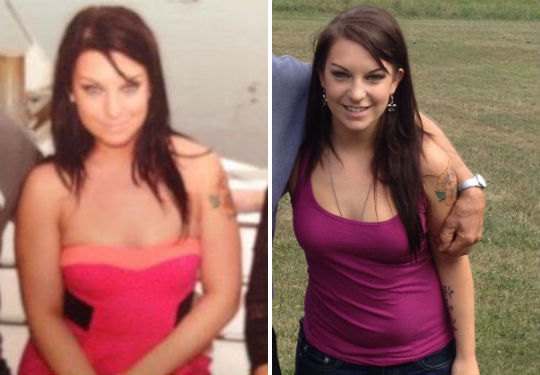
I still remember the day I stepped on the scale. I was positive it had somehow malfunctioned. I knew I gained some weight, but I didn’t think I gained that much. My biggest gripe about the weight gain was how I felt inside. I was ashamed of my appearance and every time I looked in the mirror I just hurt. I had never experienced the insecurities and deep down hurt that comes with weight gain. When I closed my eyes, I was a beautiful, confident and strong woman. The moment I opened my eyes and saw what was in front of me, it was like looking at a stranger. That was not me. That was not who I wanted to be. I was drained, and I knew I needed to drop the weight or forever be unhappy with myself.
I ultimately decided to stop taking my SSRI medication since it was apparent it was contributing to my weight gain. It took me three months to wean myself off of the drug. If I stopped taking it immediately I would have horrible withdrawal symptoms including vomiting, tremors, muscle spasms, and seizures. Sounds healthy, right? A month after completely stopping the medication, I had episodes of vertigo and often felt nauseated. I was still at my 140 mark and decided to try the weight-loss program Weight Watchers, as suggested by a friend. I lost ten pounds, dropping my weight to 130, but I was completely dissatisfied with the program. The best way to describe it is that I felt “hangry” all the time! I was so hungry each day that I was just an ill-tempered mess to be around. I could never turn Weight Watchers into a lifestyle, so I decided to do more research and find something better suited for me.
Around the time I gave up on Weight Watchers I came across the website Nerd Fitness, which was giving praise to Mark’s Daily Apple. I went to the website and became intrigued with the idea of a primal lifestyle. After reading several articles that Mark wrote, I decided to purchase The Primal Blueprint and give primal living a go. In the book, I was shocked to find out that 80% of body composition is determined by what you eat. In previous years I had been exercising extensively when I should have been focusing more on what I was putting into my body.
I started the primal lifestyle slowly. I cut out bread and pasta and increased my protein and vegetable intake. I dropped weight slowly and steadily; about a pound per week. In the following weeks, I felt my energy increase dramatically. With increased energy, I thought, “Why not start to exercise to speed up the process?” I decided to start cycling and rode my bike each morning after breakfast. I was both seeing and feeling phenomenal results. Seeing results while feeling both emotionally happy and physically satisfied (no hunger pains to be found), I removed even more unnecessary foods from my diet. I felt like I no longer needed legumes or dairy, and I started purchasing my produce from local farmers.

By the summer of 2013, I weighed 110 pounds without portion control or calorie restriction. I was absolutely ecstatic! I continued to do research and make minor adjustments here and there while exercising when and how I wanted to. I was still cycling daily, loving the fresh air and the gratification after a long ride. I added hiking to the mix and interval sprints every so often, whenever I felt like I needed a boost of exhilaration. Weekly yoga sessions helped calm my mind and my stress level was minimal.
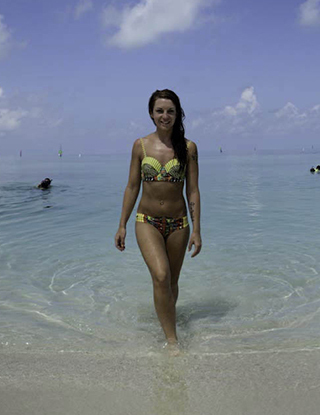 Now, as of July 2014 at 25 years old, I fluctuate between 100-105 lbs. I haven’t had an anxiety attack in years and I feel satisfied with the primal lifestyle. I made friends who are also into primal living and we have dinners together every month—sharing new recipes and enjoying natural and wholesome foods. I have no intention or desire to ever go back to conventional eating or over-training. Many people who ask about my diet and exercise habits scoff at primal living, yet they are also the ones that are lethargic and overweight. I’m proud to have started such a journey in my life and I’m glad that I finally feel comfortable in my own skin. I feel like myself again.
Now, as of July 2014 at 25 years old, I fluctuate between 100-105 lbs. I haven’t had an anxiety attack in years and I feel satisfied with the primal lifestyle. I made friends who are also into primal living and we have dinners together every month—sharing new recipes and enjoying natural and wholesome foods. I have no intention or desire to ever go back to conventional eating or over-training. Many people who ask about my diet and exercise habits scoff at primal living, yet they are also the ones that are lethargic and overweight. I’m proud to have started such a journey in my life and I’m glad that I finally feel comfortable in my own skin. I feel like myself again.
Katie





September 18, 2014
Join Us Next Week at the 5th Annual PrimalCon Oxnard!
 We’ve just finalized our room block at the Embassy Suites Mandalay Beach Resort for PrimalCon Oxnard September 25-28th. We’ll have over 100 guests taking that place over and hitting the omelet bar so hard every morning they won’t know what hit them! I grabbed just a couple extra rooms at our incredible discount rate (starting $159/night), and the rest have been released to the public at the premium summer rates of $259/nite on up. So, if you want to come to PrimalCon, contact our offices immediately (888-774-6259 or 310317-4414) so we can secure you a suite at the resort and a ticket.
We’ve just finalized our room block at the Embassy Suites Mandalay Beach Resort for PrimalCon Oxnard September 25-28th. We’ll have over 100 guests taking that place over and hitting the omelet bar so hard every morning they won’t know what hit them! I grabbed just a couple extra rooms at our incredible discount rate (starting $159/night), and the rest have been released to the public at the premium summer rates of $259/nite on up. So, if you want to come to PrimalCon, contact our offices immediately (888-774-6259 or 310317-4414) so we can secure you a suite at the resort and a ticket.
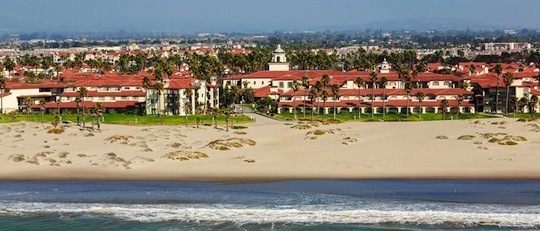

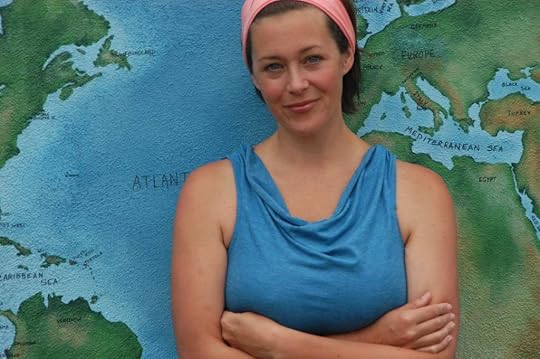 Great news: Katy Bowman, in the midst of a whirlwind global tour to promote her new Move Your DNA book, has found a spot in her hectic schedule to deliver a keynote presentation on Sunday morning at PrimalCon (she previously had to cancel due to a book signing event in Seattle that weekend). Katy will talk about the importance of general everyday movement to support your health at the cellular level. In particular, how to counter the tremendous momentum we have in daily life toward stillness and lack of variation.
Great news: Katy Bowman, in the midst of a whirlwind global tour to promote her new Move Your DNA book, has found a spot in her hectic schedule to deliver a keynote presentation on Sunday morning at PrimalCon (she previously had to cancel due to a book signing event in Seattle that weekend). Katy will talk about the importance of general everyday movement to support your health at the cellular level. In particular, how to counter the tremendous momentum we have in daily life toward stillness and lack of variation.
As you may know, Katy and I are working on a comprehensive all-digital instructional course together called “Don’t Just Sit There!”, due for release late this year. Katy’s rapid fire presentation offers a lively mix of humor, science, and practical tips you can use every day to counter the health risks of the active couch potato syndrome.
We are also going to pack up some of our high-tech standup workstation equipment from the Malibu headquarters and create a mock office environment in the resort ballroom for you to test out and have some fun with over the weekend. I hope to see you there, especially since this will be our last chance to gather for a while. In 2015, we have plans for one grand PrimalCon in Oxnard on Sept 24-27th. And I’m also appearing at Thr1ve Australia’s PrimalCon-style gathering scheduled for March 13-15 at Manly Beach near Sydney. (The Thr1ve event website is coming soon. Check back for details.)
That’s all for now. Stay tuned for the regularly scheduled Friday Success Story. Grok on!





Walking: The Human Condition
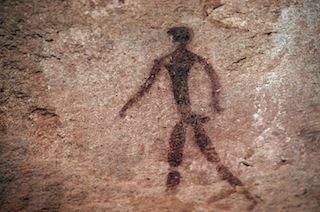 When early humans stood erect over the African savannah, our improved vantage point gave more than views of prey and predator, berry bush and honeybee hive, nut tree and watering hole; we saw possibilities. We saw the horizon stretching out until what appeared to be infinity. We saw sunsets and sunrises, mountains and valleys, stars and constellations and galaxies. The world grew. And we viewed this massive world with a childlike curiosity that made just looking insufficient. We had to touch, visit, and experience it.
When early humans stood erect over the African savannah, our improved vantage point gave more than views of prey and predator, berry bush and honeybee hive, nut tree and watering hole; we saw possibilities. We saw the horizon stretching out until what appeared to be infinity. We saw sunsets and sunrises, mountains and valleys, stars and constellations and galaxies. The world grew. And we viewed this massive world with a childlike curiosity that made just looking insufficient. We had to touch, visit, and experience it.
So we walked.
Some of us walked north from our East African homelands across the Levantine corridor to reach the Near East (or what became the Fertile Crescent before agriculture stripped it bare). From there, humans walked deeper into the new land, some heading south into the Indian subcontinent, others exploring the far reaches of the east or the steppes of central Asia and on into Europe.
Other African groups spread south and west across the rest of the continent or, taking advantage of low water levels, crossed the Red Sea at the Horn of Africa, alternately walking and perhaps rafting along Asia’s southern coastline until Indonesia and, eventually, Australia.
And at some point, humans walked clear across the Arctic land bridge to North America. A few of us settled in that far north, happy with walrus and seal and salmon. Others kept walking, making their way through Canada, America, and down on into Latin America.
Walking was freedom. There was always something else just around the bend, a new life, a new beginning, new plants and animals to eat (and eventually tame). If things got awkward or a conflict arose within a group, people could always walk away. There were no borders or boundaries to respect, no real estate to guard. Life wasn’t exactly easy or idyllic, but we had options. We always had a way out if we were willing to walk.
And when we’d stay and explore an area, ingratiate ourselves with the new surroundings, get comfortable – we didn’t stop walking. We didn’t hunker down, lay down roots, confine ourselves to a plot of land, and get fat. After all, we were hunter gatherers, largely nomadic, who went where the food went and grew.
So:
We walked short distances. A few hundred yards to gather kindling and wood for the morning fire. We walked a mile at midday to fetch water and maybe gather some nuts and tubers. We walked to the watering hole to wait for thirsty game; if successful, we walked back to camp carrying our prize. If modern foragers like the Ache or Hadza are any indication (PDF), we walked anywhere from 6 to 16 kilometers on an average day. And our short distance walking was spread throughout the day, not clumped together in a single uninterrupted session on the treadmill after work.
We walked under load. We carried armfuls and baskets and skins of tubers, nuts, fruits, and the rare honeycomb. We hauled butchered animal parts and piles of shellfish, small game and fish. We carried children. Shopping carts, strollers, and delivery services were unavailable.
We walked on uneven terrain. The natural world isn’t flat and linear and made of concrete. There are gradations. Roots and rocks jut out and must be avoided or surmounted. Every step is different than the last, and this makes walking on uneven terrain far more energetically demanding than walking on flat terrain, and far better at improving and maintaining balance, physical fitness, and metabolic health.
We walked kind of funny, unlike any other bipedal animal, most of whom have tails to counterbalance. We stand atop two relatively small feet and we’re tall, so we’re constantly teetering to one side or the other and making infinitesimally small corrections to stay upright that we don’t even notice we’re making. Walking is falling forward and swinging a leg out to catch ourselves before we faceplant. It’s most evident in babies who have mastered the “falling” part without figuring out the “swing your leg out” part. But we all do it – athletes, hikers, mallrats, seniors. If we’re walking, we’re falling and catching ourselves.
And yet as silly as it sounds, this funny way of walking worked for us. So well that constant, frequent walking and humanhood are inseparable. One and the same. Our genome has developed in the context of frequent walking. To be human is to walk:
We’re bipedal. We have two free hands to carry supplies, tools, food, water, weapons as we walk; we have opposable thumbs and brains of sufficient capability to fashion packs, ropes, lashes for carrying, pulling, dragging even more supplies, tools, food, water, weapons along.
We’re upright and relatively hairless. The sun hits us at an angle rather than directly head-on, keeping us cooler than a quadruped whose back is fully exposed. We also thermoregulate by sweating through glands that line our skin’s surface. Improved thermoregulation lets us walk greater distances without overheating.
We’re heel-strikers. Aside from bears and great apes, every other animal walks on its toes. Humans lead with the heel and roll to the toes when we walk, maximizing our walking economy and allowing us to cover great distances without getting winded or expending much energy.
This perfect storm of anatomy, anthropometry, and biology made us obligate walkers so that even as food sources changed, as stalks of wheat and fences shot up around us, as nomadism gave way to agrarianism gave way to urbanism, humans used controlled falling as our primary mode of transportation. Neolithic farmers walked. Medieval peasants walked. Mayan warriors walked. Slaves, monks, artisans, fish mongers, cobblers, Union soldiers all walked. Victorian-era laborers walked an average of six miles a day. Modern Amish, a decent proxy for pre-industrial agrarian people, still walk nearly 15,000 steps (females aged 18-75) and 19,000 steps (males aged 18-75) per day (PDF). We have to walk.
It’s only in the information age – this world of Amazon same day deliveries and digital libraries in our pockets and car-dependent suburban sprawl and obese toddlers and anti-sitting campaigns – that we’ve stopped walking. But the need to walk has never left.
The human story is a story of constant movement, of progress, of yearning and seeking and exploring. Underneath all that is the simple physical act of putting one foot in front of the other. Without the controlled falling, the other stuff doesn’t matter so much or work so well.
Henry David Thoreau couldn’t “preserve [his] health and spirits” without spending “four hours a day at least – and commonly more than that – sauntering through the woods and over the hills and fields, absolutely free from all worldly engagements.” He is not alone. We can’t all achieve that level of sauntering, but I’m certain we can do a whole lot better than the amount we currently engage in. Those walking genes, those urges to explore remain within us. We should honor, respect, and indulge them.
I’d tell you to go for a walk or to take a hike, but that’s not good enough. Go for walks. Take hikes, as many as you can squeeze in. Continue the human story.
Prefer listening to reading? Get an audio recording of this blog post, and subscribe to the Primal Blueprint Podcast on iTunes for instant access to all past, present and future episodes here.





September 17, 2014
A Brief History of the Primal Movement
 It’s relatively easy being Primal nowadays. Most restaurants have dairy-free, gluten-free options, if not entire menus devoted to Primal-friendly restrictions. Actual paleo restaurants and food trucks literally exist. Minimalist shoes are everywhere. Standing desks are standard at many corporations, a farmer’s market lurks around every corner, regular grocery stores carry grass-fed beef and butter, and Whole Foods has a paleo hot bar. Comment sections of mainstream nutrition articles are overrun with Primal supporters dropping knowledge. And in 2013, “Paleo diet” was the most searched-for diet in Google. But it wasn’t always like this. If you weren’t around for the hard scrabble days of yore, you probably don’t realize what we endured. I’m talking about the days when:
It’s relatively easy being Primal nowadays. Most restaurants have dairy-free, gluten-free options, if not entire menus devoted to Primal-friendly restrictions. Actual paleo restaurants and food trucks literally exist. Minimalist shoes are everywhere. Standing desks are standard at many corporations, a farmer’s market lurks around every corner, regular grocery stores carry grass-fed beef and butter, and Whole Foods has a paleo hot bar. Comment sections of mainstream nutrition articles are overrun with Primal supporters dropping knowledge. And in 2013, “Paleo diet” was the most searched-for diet in Google. But it wasn’t always like this. If you weren’t around for the hard scrabble days of yore, you probably don’t realize what we endured. I’m talking about the days when:
You’d get asked to leave a store for wearing “monkey toe socks.”
Waiters had no idea what “gluten-free” meant and you had to say “real butter, ya know, from cows” or else receive food cooked in butter-flavored soy oil (if they even had butter).
You were the lone dissenting voice among hundreds of commenters on a “red meat will kill you” article.
Back in 2006 when I started writing my blog – Mark’s Daily Apple – the average person had no clue about the Primal lifestyle. Those of us who espoused it were fringe characters, radicals on street corners with cardboard signs. But sometimes those crazy guys on the street aren’t so crazy. Sometimes their rants and raves catch on.
I can remember being out to dinner with people who’d ask why I wasn’t eating the bread. My wife and I would exchange a look, she’d sit back, roll her eyes as if to say “Here we go…” and I’d launch into my spiel. But once they’d heard and over the course of a dinner carefully considered it, the notion of a biologically appropriate way of eating, exercising, and living for humans made intuitive sense. By the time the check had arrived, most of the people at the table who’d been asking the questions were vowing to give the lifestyle a trial run. This wasn’t a one time thing, mind you. It happened constantly, practically every time we went out to eat with people.
And I’m willing to bet that I’m not the only one. Tens of thousands of people, maybe even hundreds of thousands, were having those same dinner conversations all over the world. Haven’t you? And that’s why I knew from the very beginning that this was big and would only grow as time went on: it worked, it made sense, and once a person discovered that, they’d fall all over themselves to tell others about it. They wouldn’t – they couldn’t – keep it to themselves. Primal living had a life of its own. It was a self-perpetuating, viral spark.
As sparks do, the movement grew.
The early days of MDA were different than today. I was still developing my philosophy of health, and my opinions were always subject to change as I grew aware of new evidence. The basic Primal Blueprint was the same, but my focus has expanded to include far more than diet, exercise, sun, and sleep. Readership was scarce back then and comment sections were often ghost towns. But I plugged away and stuck with it because I knew there was something special happening.
MDA’s web design circa 2007 was very different. Here, take a look for yourself. (Anyone reading remember those days?)

2007 was a big year. It saw the release of Gary Taubes’ Good Calories, Bad Calories, a powerful rebuke of decades of flawed government advice on nutrition, dietary fat, and disease. Taubes showed that the campaign against saturated fat and cholesterol was founded on flawed pseudoscience, and that the weight of the actual evidence suggested that animal fat and protein were benign and perhaps even essential to human health. The basic Primal postulate – that humans evolved eating ample amounts of animal fat and protein, and probably still should – had been vindicated in a widely-read treatise on modern science that had nothing specifically to do with evolutionary health. Taubes’ book got more people embarking on a path to understand proper nutritional science, a path that led inevitably to the ancestral health community.
That’s right around when I took a big step away from the orthodox paleo emphasis on “lean meats” and really embraced saturated fat. I’d never worried much about it and always felt the focus on it was way overblown, but a strong, enthusiastic endorsement was long overdue.
In 2009, after a few years of steadily growing readership, I self-published The Primal Blueprint. The book laid out, in plain terms, the health philosophy I’d spent the last couple decades discovering, developing, and refining. It quickly became a best-seller and, along with Robb Wolf’s The Paleo Solution the following year, helped establish the ancestral health movement as a legitimate force in the health sphere.
In 2010, we put on the very first PrimalCon in Oxnard, CA, a weekend gathering of Primal health and fitness experts and enthusiasts. (The next one is just a week away!) It was informative, the food was great, and everyone learned a lot about living and moving healthfully, but that wasn’t the most important aspect of the weekend. Dozens of people who’d always been the weird one at the dinner party or the gym or the night out with friends, the oddball eating salad instead of pizza, finally felt at home. They didn’t have to explain themselves. They’d found a tribe.
That 2009-2010 stretch was also a time of great change and development for the community:
It’s when the importance of “the other stuff” became crystal clear. Diet and exercise were still foremost, but community, sleep, sun, stress, circadian rhythm, light exposure, and the dangers of excessive sitting began receiving the attention they deserved well before more mainstream outlets had caught on. To put it another way, we were making standup workstations by balancing our laptops on stacks of old Vibram Fivefingers boxes before it was cool.
We realized that regular old white potatoes and white rice, former enemies of the ancestral state, weren’t so bad after all as long as you could actually use the extra carbs.
Our annual 21-Day Challenge became increasingly popular, and we finally got to put faces to the names we were all familiar with in the comment boards and the forum. We got to see families who shop like Grok, friends who picnic like Grok, people who pose like Grok, and people with Grok tattoos. Grok really was all over the world.
A slew of really great ancestral health blogs were also coming into their own and pumping out excellent material that we’re still building on today. Your Perfect Health Diets, your Chris Kressers, your Kurt Harrises, your Gnolls, to just name a few that come to mind – this is when that cadre of thinkers blew the scene wide open.
In 2011, the inaugural Ancestral Health Symposium was held at UCLA: a conference of academics, doctors, health practitioners, bloggers, authors, fitness trainers, and enthusiasts devoted to discovering the ways our ancestral traditions and evolutionary history inform and explain modern day health matters. Dozens of formal talks were given; dozens more sprung up informally in the halls. At one of the premier academic institutions in the country, the ancestral health movement had arrived.
Yeah, the community at large was making serious moves. They were building cred on multiple levels: academic, mainstream, the average Joe, the physical culture crowd. So was I. I’d already self-published several books since The Primal Blueprint – The Primal Blueprint Cookbook, Primal Blueprint Quick & Easy Meals, The Primal Blueprint 21-Day Total Body Transformation, The Primal Blueprint 90-Day Journal, The Primal Blueprint Healthy Sauces, Dressings & Toppings, and The Primal Connection – and I was ready to do more.
Now, the Primal/paleo/ancestral health community is very close. We talk – a lot. And since I’d had a lot of success self-publishing my books, other would-be authors would often approach me for advice on doing the same thing. This became an almost everyday occurrence, via email and in person at various health and fitness events. Doling out advice began to take up so much time that I started to put together a template to speed up the process. And then it hit me: why not publish them myself? So Primal Blueprint Publishing was founded in 2013, and we’ve already published seven books with several more on the way.
More PrimalCons every year, too, including in Tulum, Mexico; South Lake Tahoe, CA; Austin, TX; and Mohonk, NY. More Ancestral Health Symposiums every year. PaleoFX was another huge conference that sprung up in Austin, less formally academic than Ancestral Health Symposium and geared toward the layperson (of course, Primal laypeople run a bit more intellectually curious than the general population); 2015 will be the fourth annual event. More Google searches, more blog visitors, fewer dumbfounded looks when you tell someone “I don’t eat grains or refined sugar, and I like to walk barefoot.”
Conventional wisdom that used to look set in stone was beginning to crack. Heck, many Primal principles are finally getting mainstream media coverage. Most of the then-arcane stuff we used to talk about four or five years ago, like barefoot running, dirt, standing desks, blue blocking goggles to wear at night, and the awesomeness of bone marrow, has disseminated through to the general public. Offal is in. Cereal sales are down; butter sales are up.
What’s next?
I’ve always tried to write with clarity and simplicity so that anyone who read my books and blogs, and felt moved, could explain to their friends, family, and colleagues just what they found so engaging. And as I said earlier, it’s worked quite well; the Primal concept is simple, intuitive, and fairly easy to explain. That the diet and exercise and everything else actually work doesn’t hurt either. Our growth reflects all that.
But we needed a stable framework for information dissemination. We needed this because many Primal enthusiasts involved in healthcare and the fitness industry would email us every day asking for one. They’re chiros and MDs and dietitians, coaches and trainers and massage therapists, yoga instructors and midwives. And maybe they’re just regular folks who are really, really enthusiastic about the health benefits of a biologically appropriate lifestyle and want to help the people they care about get the same results. Whatever their background, they wanted to help people join the Primal movement and they needed a comprehensive, structured guide to convincing the uninitiated and converting the dubious.
I saw a big opportunity to change how we do health in this country – and in others.
Now, in 2014, the release of the Primal Blueprint Expert Certification program marks the latest – and most important – development in the evolution of the Primal movement. A rigorous, intensive educational program similar in difficulty and intensity to an upper division level college course, the “Cert” prepares health and fitness professionals and motivated laypeople to deliver lasting change to clients, friends and family.
I’m incredibly excited to see what the future brings and to help the movement grow even more. Modern life has made us unhealthy, but it doesn’t have to be that way. Nor will it.
I hope you’ll join us in changing the world.
Download the full-size version of the Grok around the world image at the top of this article (large file)
A version of this article was recently published on Bare-Essentials.com
Prefer listening to reading? Get an audio recording of this blog post, and subscribe to the Primal Blueprint Podcast on iTunes for instant access to all past, present and future episodes here.





September 16, 2014
UPDATE: Mark’s Daily Apple Articles Coming to the Primal Blueprint Podcast
 At the request of numerous Mark’s Daily Apple readers, my podcast team and I are now bringing Mark’s Daily Apple articles to the Primal Blueprint Podcast!
At the request of numerous Mark’s Daily Apple readers, my podcast team and I are now bringing Mark’s Daily Apple articles to the Primal Blueprint Podcast!
Select articles from Mark’s Daily Apple will be published in audio format, so if you prefer listening to reading, or simply have a difficult time keeping up with the daily articles, you’re in luck. Now you can listen to articles while on the go and never miss a beat.
To start, we’re going to record and publish all future, relevant Tuesday, Wednesday and Thursday articles. In fact, we’ve already begun doing this. The following articles from last week are available right now. You can click the links below to access them.
How Exercise Makes Us Feel
12 Signs You Need to Eat More Protein
Rajio Taiso: Why You Should Start Doing Light Morning Workouts
The easiest way to access future Mark’s Daily Apple article podcasts is to subscribe on iTunes or whatever else you use to stream podcasts on your phone, computer or mp3 player.
In addition to this, we’ve got a few other things up our sleeves. Over the next four weeks we’ll be publishing the following “Mark’s Daily Apple Best of 2014″ podcasts. The first two are already available. Stay tuned for the rest. They’ll be published on Mondays.
Mark’s Daily Apple Best of 2014, Vol. 1: Food and Nutrition
Mark’s Daily Apple Best of 2014, Vol. 2: Exercise and Performance
Mark’s Daily Apple Best of 2014, Vol. 3: Gut Health
Mark’s Daily Apple Best of 2014, Vol. 4: Primal Criticism Rebutted
Mark’s Daily Apple Best of 2014, Vol. 5: Getting Unstuck
Mark’s Daily Apple Best of 2014, Vol. 6: Gluten
That’s not all. We’re also going to be reaching back into our archives to publish “Mark’s Daily Apple Best of All-Time” articles. These will be published each Friday for the foreseeable future, and we’ll be starting with the Definitive Guide series. The first one is already available: The Definitive Guide to the Primal Blueprint.
And for all you YouTube lovers out there, all of these Mark’s Daily Apple podcasts will be published on the Mark’s Daily Apple YouTube channel, too.
Last, but not least, we’ll continue to publish original Primal Blueprint Podcast episodes. We’ve had a great time creating 35 weekly episodes this year. We’ve covered a lot of ground in that time, interviewing numerous special guests, answering your most pressing Primal questions, and otherwise exploring how to be healthy, strong, fit, happy and productive with the least amount of pain, suffering and sacrifice as possible. We may publish these less frequently than once weekly going forward, but stay tuned! And if you have any questions or topics you’d like covered, hit me up with a voicemail message using the blue “Submit a Question” button in the sidebar.
Thanks to everyone that has already made the Primal Blueprint Podcast a success, and let me know what you think about these new podcast plans. Grok on!





September 15, 2014
Dear Mark: Wife’s Weight Gain; Upper Arm Fat
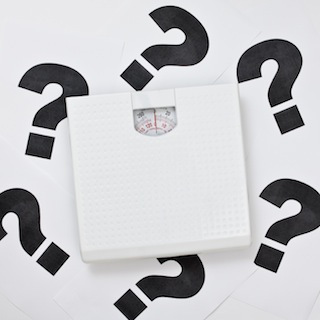 For today’s edition of Dear Mark, we’ve got a two-parter. First up is a question from a reader whose wife has gained weight following the Primal Blueprint way of eating and after completing a Whole30. She seems to be doing everything right, in other words. What could explain the weight gain? Next, I discuss what can be done – if anything – about upper arm fat. It might be hereditary, but that doesn’t mean we’re totally at the mercy of our genes. And even if we are, we can change how we react.
For today’s edition of Dear Mark, we’ve got a two-parter. First up is a question from a reader whose wife has gained weight following the Primal Blueprint way of eating and after completing a Whole30. She seems to be doing everything right, in other words. What could explain the weight gain? Next, I discuss what can be done – if anything – about upper arm fat. It might be hereditary, but that doesn’t mean we’re totally at the mercy of our genes. And even if we are, we can change how we react.
Let’s go:
Dear Mark,
First off I just wanted to thank you for all that you do. I’ve been primal for over a year, have lost over 35 lbs., and am in the best shape of my life. I have consistent energy levels, and am much healthier overall. The Primal Blueprint and MDA have changed my life, and I evangelize both to all who are interested.
My wife has also accompanied me on this journey. Her results have not been quite so spectacular. While she also has enjoyed more consistent energy levels, she has actually gained a significant amount of weight. Approximately 15 pounds so far. I only weigh 10 lbs. more than her now (156 vs. 146).
She was never as strict as I was when it came to what she was eating, but overall she ate pretty well. She had an affection for baking paleo baked goods, which in my opinion really aren’t primal at all. That said, she was eating much better than she ever had previously in her life. I suggested that we try a Whole30 and follow it 100%. We’re almost done with our Whole30 now, and she is up 3 – 5 lbs. from the start of the Whole30. It’s very perplexing.
I have to imagine this is hormone related. I’m not sure what else would cause this to happen, but it’s very discouraging for her, especially when in the face of my results. Do you have any suggestions or insight that may help us figure out what’s going on? We’re not really sure how to “troubleshoot”. Perhaps she should get tested for thyroid issues?
Thanks so much!
Kris
Thanks, Kris. I’m glad to hear it’s worked so well for you. I’m sorry it (apparently) hasn’t for your wife.
A few thoughts:
The nutrient density and protein and fat content of a Primal way of eating, or a Whole 30, works almost too well at lowering appetite, increasing satiety, and triggering spontaneous and inadvertent calorie reduction. It’s rare, but some people – and this seems to happen more frequently in women than men – experience such a drastic reduction in metabolism upon lowering their food intake that they actually gain weight. Their “calories out” drops because of insufficient “calories in.” The low calorie intake is a signal to the body to reduce expenditure, and this is actually why a lot of people fail with traditional diets: not only are they struggling against insatiable hunger, they’re lowering their energy expenditure.
If she’s intermittent fasting, that may be the problem. You may recall the post I did a couple years back addressing this topic. Many women simply don’t do well fasting. They either stall or gain. They may not even realize there’s an issue because of the aforementioned lack of hunger during the fasting period. But if you’re gaining body fat after a few weeks of skipping meals, try not skipping them. It’s not working.
So in general, eating too little food can be counterproductive. So too can eating too infrequently. Watch out for both.
I’d also rule out thyroid with a test. Since thyroid hormone often plummets on super low-calorie diets, thyroid is a good test to run. But the fact that her energy has improved makes me wonder if it’s that. That shouldn’t happen if thyroid and/or energy expenditure are tanking.
Some women do gain weight in the “right places.” And I don’t mean to sound (that) sleazy. For many women it’s completely natural to have a higher body fat level and accumulate more fat in the gluteofemoral region – the hips, butt, and thighs – because that’s where women store DHA for future baby brain construction. That’s probably why gluteofemoral fat is notoriously stubborn and hard to burn – because it’s a reliable, secure way to store an important nutrient (DHA) that’s often scarce during pregnancy. She needn’t worry about gluteofemoral weight gain (and you might dig it); it’s actually a sign of good metabolic health.
The weight gain might be a good thing, in other words. If all the other changes from adopting the lifestyle (like increased energy) have been beneficial, the weight gain might also be “good” or “what the body needs.” Is she exercising? If so, are her numbers improving? Is she getting stronger? Faster? She might have put on some muscle. She may have needed the weight.
The scale doesn’t tell the whole story. Where the weight has gone, what comprises it, and any other effects from the diet must all be considered and weighed to get an accurate picture of the situation.
I am depressed by my upper arms. They are flabby and compared to the rest of my body are quite large. My mother has the same. Is there anything I can do about it?
M. Williams
Brachium butter beating you up? Have I got just the thing for you!
The name of the game when it comes to burnin’ arm flab, my dear, is vibration! You need to make the arm an inhospitable home to make that pesky limb lard skedaddle. Just like you’d do whatever you could to move out of an apartment if a subway rumbled overhead every few minutes, arm fat cannot tolerate the agitation from constant vibration.
Now, there are plenty of options to try. You could put on a hardhat and get a job as a jackhammer operator. You could hold on to soda pop bottles filled with Mexican jumping beans. You could do this move.
Whatever method you choose, this next step is crucial. Once you’ve got the arm flab on the run, you’ll have to graduate to full body vibration. If you sit still, the fat will simply relocate elsewhere. Your wrists, your ankles, your cheeks. There’s literally no telling where a fleeing band of fatty acids desperate for a home will migrate. Full body vibration prevents the fat from ever settling down or getting its bearings. Most arm fat gives up after about 20 minutes of vibration. If it’s a particularly plucky group, you may have to vibrate for an hour or two until they lose all hope.
Just don’t let up until you get the urge to visit the toilet. That’s how you know the fat is finally leaving.
In all seriousness, a lot of fat deposition is hereditary and we already know that spot reduction doesn’t work. You can’t force your body to lose weight in a specific area by training that area. If your genes are inclined to deposit fat in your upper arms, that might be unavoidable. You could starve yourself down to unhealthily low levels of body fat, but I would strongly advise against it. Your health will suffer – remember that women generally function better with more body fat than men – and you will be disproportionately skinny in other areas.
It could be hormonal. I’d get a full endocrine panel (thyroid, testosterone, estrogen, progesterone, etc.) done to confirm your hormone levels are within range.
Make sure you’ve got all your other ducks in a row:
Sleep well. Don’t stay up late and skip sleep for silly reasons. Avoid blue light at night, and electronics in general.
Eat right. If you’re eating too many carbs for the amount of exercise you’re doing, cut back. Don’t fear healthy fat. Eat enough protein.
Exercise consistently. Lift heavy things a couple times a week, walk a ton, and do something really intense once or twice a week. Maybe it’s a sprint session on a bike or on a track. Maybe it’s a few sets of burpees.
Take steps to reduce, mitigate, or rethink stress.
Find joy on a regular basis, whether it’s being intimate with your partner, curling up with a great book or flick or TV series, taking a trip, going for a hike, playing with your dog (or cat), hosting a dinner party, or watching the sun rise or set. Or all of them. Try to pick at least one “small” thing to enjoy every day and one “big” thing to enjoy every week.
Get sun, not too much.
Get nature, more than you think you need.
You know, the basics. If you’re doing all that and your arms are still a bit flabbier than you’d like, realize and accept that bodies come in all shapes and sizes. Some people, even if they’re fit as a fiddle, may not fall into the “svelte” category. And while fashion magazines often suggest otherwise, that’s OK. In fact, that’s more than OK. There’s perfection to be found in all types. Love your body. It’s the only one you’ll ever have. How? Well, that’s a topic for another article entirely. (Stay tuned.)
I hope this helps, M. and Kris, and be sure to stick around for the comment section. Our brilliant readers always chime in with some piece of advice I’d forgotten or overlooked.
Thanks for reading everyone! Let’s see if we can help M. and Kris in the comments, huh?





September 14, 2014
Weekend Link Love – Edition 313
 Paleo Lifestyle Magazine is running a fantastic giveaway. Enter the Ultimate Paleo Kitchen giveaway for your chance to win $300 worth of kitchen gear and cookbooks.
Paleo Lifestyle Magazine is running a fantastic giveaway. Enter the Ultimate Paleo Kitchen giveaway for your chance to win $300 worth of kitchen gear and cookbooks.
Research of the Week
A five minute walking break (2 MPH) undoes the harmful effect an hour of sitting has on your arterial function. That’s doable.
A history of farming rice appears to make people more interdependent, while a history of farming wheat appears to make them more independent.
Neanderthals made engravings in stone serving no utilitarian purpose (also known as art), indicating a capacity for abstract thought.
Blue light at night isn’t so good for your vision, either.
So nice, evolution did it twice: caffeine evolved independently in coffee and tea.
New Primal Blueprint Podcasts
The Primal Blueprint Podcast – Episode #35: Interview with Elle Russ, PB Certified Expert and Personal Coach – Learn how Elle went from sugar-burning chronic cardio addict to fat-burning success story, as well as how her experience with the Primal Blueprint Expert Certification is supporting her burgeoning personal coaching business.
Each week, select Mark’s Daily Apple blog posts are prepared as Primal Blueprint Podcasts. Need to catch up on reading, but don’t have the time? Prefer to listen to articles while on the go? Check out the new blog post podcasts below, and subscribe to the Primal Blueprint Podcast here so you never miss an episode.
Rajio Taiso: Why You Should Start Doing Light Morning Workouts
12 Signs You Need to Eat More Protein
How Exercise Makes Us Feel
Interesting Blog Posts
Canada’s Heart and Stroke Foundation just cut their recommended intake of free sugars (which includes any sugar freed from its natural packaging; fruit juice applies) way back. Not bad.
You’ve heard how important it is to walk tall. What about walking straight?
Media, Schmedia
Is our fear of fat melting?
The mile run’s making a comeback.
Everything Else
In search of darkness, a rapidly disappearing natural resource.
Culture alters sensory perception.
The Red Delicious is a disgusting, mealy disappointment. How did it become the world’s most popular apple?
California olive oil aims to topple traditional Spanish, Greek, and Italian dominance over the industry, and the Europeans are getting nervous. This should improve quality across the board.
Breakfast cereal consumption is in decline.
Have you tried CropFit?
Grandfather completely mystified by grandson’s priorities.
Recipe Corner
On a hot day, there’s nothing like a cool bowl of watermelon gazpacho. And it’s sexy, too.
Although Garfield probably wouldn’t approve, zucchini lasagna is a delicious pasta-free compromise.
Time Capsule
One year ago (Sept 14 – Sept 20)
The Primal Blueprint Refresher: A Dramatic Reading – I’m still trying to get the Geffen Playhouse in LA to pick this up. In the meantime, you can read it.
18 Ways to Set Yourself Up to Succeed in Your 21-Day Challenge – Even if you’re not in the midst of a formal challenge, these tips are still helpful for everyday success.
Comment of the Week
(Whose attention perked up at the mention of cannabinoid?)
Gahhhhh stop calling me out
– Ha! I knew I’d get a few of ya.
Further Your Knowledge. Deepen Your Impact. Become an Expert! Learn More About the Primal Blueprint Expert Certification




Mark Sisson's Blog
- Mark Sisson's profile
- 199 followers




